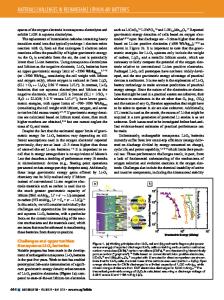Chalcogen cathode and its conversion electrochemistry in rechargeable Li/Na batteries
- PDF / 6,207,807 Bytes
- 14 Pages / 595.276 x 793.701 pts Page_size
- 73 Downloads / 325 Views
tps://doi.org/10.1007/s11426-020-9845-5
SPECIAL ISSUE: 2020 Emerging Investigator Issue
Chalcogen cathode and its conversion electrochemistry in rechargeable Li/Na batteries Ya-Hui Wang 1
1,2†
1,3†
1,3
1,3
, Xue-Ting Li , Wen-Peng Wang , Hui-Juan Yan , 1,3* 1,3 Sen Xin & Yu-Guo Guo
CAS Key Laboratory of Molecular Nanostructure and Nanotechnology, CAS Research/Education Center for Excellence in Molecular Sciences,
Beijing National Laboratory for Molecular Sciences (BNLMS), Institute of Chemistry, Chinese Academy of Sciences (CAS), Beijing 100190, China; 2 School of Science, Beijing Jiaotong University, Beijing 100044, China; 3 University of Chinese Academy of Sciences, Beijing 100049, China Received May 21, 2020; accepted August 11, 2020; published online August 26, 2020
Chalcogen elements, such as sulfur (S), selenium (Se), tellurium (Te) and the interchalcogen compounds, have been studied extensively as cathode materials for the next-generation rechargeable lithium/sodium (Li/Na) batteries. The high energy output of the Li/Na-chalcogen battery originates from the two-electron conversion reaction between chalcogen cathode and alkali metal anode, through which both electrodes are able to deliver high theoretical capacities. The reaction also leads to parasitic reactions that deteriorate the chemical environment in the battery, and different cathode-anode combinations show their own features. In this article, we intend to discuss the fundamental conversion electrochemistry between chalcogen elements and alkali metals and its potential influence, either positive or negative, on the performance of batteries. The strategies to improve the conversion electrochemistry of chalcogen cathode are also reviewed to offer insights into the reasonable design of rechargeable Li/Nachalcogen batteries. energy storage, Li/Na-chalcogen battery, chalcogen cathode, conversion reaction Citation:
Wang YH, Li XT, Wang WP, Yan HJ, Xin S, Guo YG. Chalcogen cathode and its conversion electrochemistry in rechargeable Li/Na batteries. Sci China Chem, 2020, 63, https://doi.org/10.1007/s11426-020-9845-5
1 Introduction Chalcogen elements, such as S, Se and Te, have a long history in building alkali-metal batteries. For example, the primary lithium-sulfur (Li-S) battery has already demonstrated its military use, while the rechargeable sodium-sulfur (NAS) battery, as was invented and patented by the Ford Corporation in 1960s, has shown its promises for stationary storage in China and Japan [1]. Se and Te, on the other hand, are demonstrated cathode materials with promises for rechargeable Li/Na batteries [2,3]. Although target markets are
†These authors contributed equally to this work. *Corresponding author (email: [email protected])
to be developed, rechargeable Li/Na-chalcogen batteries have drawn increasing attention from both the academic and the industrial fields in the past few years, as the cathodeanode combinations between chalcogen elements and alkali metals could lead to higher theoretical energy outputs than the convention
Data Loading...











